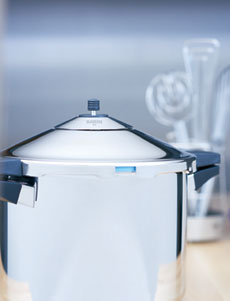
Cook faster, preserve nutrients, save money and more with pressure cooking. Above: The Kuhn Rikon Duromatic “stock pot” pressure cooker.
|
KRISTI EVANS is an intern at THE NIBBLE.
|
|
June 2008
Last Updated July 2010
|
 |
Pressure Cooking
Page 2: The Benefits Of A Pressure Cooker
This is Page 2 of a four-page article. Click on the black links below to visit other pages.
The Benefits Of Pressure Cooking
Cooks faster...retains more nutrients....saves money on ingredients and fuel. And it’s technology at its best. Are any other reasons needed to buy a pressure cooker? Let’s take a look at the benefits of a pressure cooker, one by one.
Save Time
The greatest benefit of owning a pressure cooker is the faster cooking time. Most foods cook in approximately 1/4 to 1/3 the time as traditional stovetop or oven cooking. In many instances, pressure cooking is faster than even a microwave. For example:
| Food |
Traditional Time |
Pressure Cooking Time |
Black Beans
Whole Chicken
Brown Rice
Whole New Potatoes
Beef Stew
Pasta Sauce
|
2-1/2 hours
15 minutes/lb
45 minutes
25-30 minutes
2 hours
1-1/2 hours
|
10-12 minutes
5 minutes/lb
20-22 minutes
5-6 minutes
15-20 minutes
20 minutes
|
If it sounds too good to be true, trust us, it isn’t. If you want to cook your favorite foods in a hurry, a pressure cooker will be your new best friend.
Save Money
A pressure cooker can take a bite out of your supermarket bill, since you can now purchase tougher cuts of beef or beans and inexpensive legumes, and cook them in a fraction of the time. The increased pressure during the cooking process softens fibers in foods, tenderizing the toughest meats and beans. Comfort foods which can take hours to cook are now ready in minutes. There is no need to buy frozen dinners when fresh vegetables, meats and grains can be made in the same amount of time.
And, faster cooking means a lower gas or electric bill.
More Vitamins & Minerals
Because very little water is used in pressure-cooking, few vitamins and minerals are lost to the cooking water. This allow vegetables, in particular, not only to retain their vitamins but to keep their vivid colors as well.
Space Savings
Pressure cookers are very versatile; they can cook a wide variety of foods in just minutes, from first courses to main dishes to desserts. There are as many recipes as you need, for a far wider variety of foods than you could make on the same one burner with just one pot or pan. Instead of taking up your oven and all four stove burners, you can create a three-course meal all at once in just a pressure cooker. It also takes the place of other cookware, including a Dutch oven, steamer, braising pot and more.
For people who live in small spaces, a pressure cooker isn’t an extra piece of cookware to make room for: It can take the place of several other pieces.
How Does A Pressure Cooker Work?
The principle of pressure cooking is really quite simple.
- A pressure cooker is airtight, so pressure builds up inside the cooker as the liquid inside comes to a boil.
- The pressure is controlled by adjusting the internal heat, which creates steam. The steam trapped in the pot causes the internal temperature to rise beyond what it would be capable of reaching under normal room pressure—i.e., in a traditional lidded pot.
- Simple physics proves that food cooked at a higher temperature and under pressure, cooks faster. Most foods can be cooked at 15 psi—pounds per square inch—above the external pressure.
- The pressure further causes the ingredients in dishes like stews and pasta sauces to quickly mingle and intensify in flavor.
- Steam is also a highly efficient cooking medium, effective for everything from delicate seafood and crisp vegetables to large cuts of meat.
Continue To Page 3: How Does A Pressure Cooker Work?
Return To Articles Index, Above
© Copyright 2005-
2025
Lifestyle Direct, Inc. All rights reserved. Images are the copyright of their respective owners.

|




